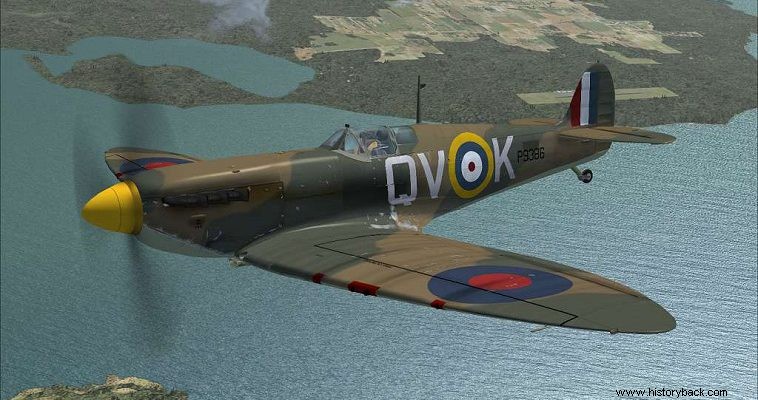
Regarded as one of the most iconic aircraft of all time, it saw action on most fronts of WWII from western Europe, the Mediterranean, North Africa and the Soviet Union, to the Far East and the South Pacific, and his name became inextricably linked with the Allied victory against Nazism. It was the only warplane to remain in production before, during and after the war. A total of 20,341 Spitfires were built, with more than twenty different versions, not including any modifications made outside the factory.
It was loved like no other fighter aircraft by the pilots who flew it on operations for its reliability as a supreme interceptor and stalker, but also for its rugged design lines with its elliptical wings. "The Spitfire is like a thoroughbred racehorse, light, fast, flexible and above all, beautiful", Wing Commander Konstantinos Hatzilakos, one of the last surviving veteran aviators of the Middle East, who landed with ' such an aircraft in Athens liberated from the Nazis in November 1944.
March 5 marked 85 years since the first test flight of the original Spitfire K5054 from Hampshire in south-east England, an area where the fiercest dogfights between the Royal Air Force and the Luftwaffe took place in the summer of 1940 during the Battle of Britain, when the Hitler wanted to gain air superiority over Great Britain in order to launch an invasion operation by sea.
A legend is born...
The Spitfire "brainchild" of the British aeronautical genius Reginald J. Mitchell, chief designer of the manufacturing company Supermarine had racing origins, from the time when the company manufactured high-speed racing seaplanes in the 1930s. With such a seaplane, designed by Mitchell, the British had won in 1931, for the second year in a row, the "Snyder Trophy" the international air races of the time. Soon this seaplane would also break the world speed record by flying at 651 km/h.
When on March 5, 1936, Supermarine test pilot Matt Summers was about to close the cockpit canopy of the prototype Spitfire "Type 300", which had a two-bladed wooden propeller and a 750 hp Rolls-Royce Merlin engine, he could not imagine that with his historic flight he would essentially be the first of the "Few", i.e. the pilots who four years later defended the United Kingdom with such aircraft from Luftwaffe raids and prevented the German invasion.
"Don't touch anything," he appears to have told the engineers when he landed fifteen minutes later. According to witnesses, the landing gear had not been retracted in this maiden flight for fear of some unforeseen entanglement. After all, it was also one of the first chasers with a retractable landing gear.
The original design called for only four machine guns, rather than the eight later fitted, simply because there was a shortage of machine guns just before World War II. But the insistence of an RAF officer-advisor to Fred Hill, who with his 13-year-old daughter Hazel, who was a maths genius, proved by complex algorithms that the new super-stalker should be equipped with eight machine guns, capable of firing at least 1000 rounds per minute if they wanted to have a pursuit aircraft superior to the fighters of the time.
In September 1937, the K5054 was designed to carry eight 0.303-inch Browning machine guns and was ready for industrial production. The first such type was the 'Spitfire Mark I'. The first order from the Air Ministry was for 310 aircraft. The RAF's 19th Fighter Squadron was the first to be equipped with the 'Mark I'.
Unfortunately Spitfire designer Reginald J. Mitchell did not live to see his achievement go into production, nor to dominate the airwaves, as he died of cancer at the age of 42 in the summer of 1937. In a tragic irony, the prototype K5054 crashed on September 4 1939, killing its pilot, just one day after Britain declared war on Nazi Germany, having already served the purpose for which it was designed:An ideal plane at a time when it had to defend the British Isles from an attack coming from continental Europe.
From the 20th to the 21st century
Of the more than 20,000 Spitfires built for the needs of the war from 1938 to 1948, only 240 survive today, of which around 60 are in airworthy condition. One of them is the Greek Spitfire MJ755, which was recently rebuilt in Biggin Hill, Great Britain on behalf of the Air Force, and is expected to return to Greece at the end of the quarantine, in order to participate with its flights in historical anniversaries and other events .
There are another 70, which adorn museums and private collections around the world as static exhibits, while another 110 are in storage awaiting reconstruction. Locating, recovering and rebuilding a Spitfire is often difficult and quite expensive. One such example is Spitfire P9374, type "Mk1", which was recovered in the 1980s from a beach in Calais, where it had been buried for forty years after the Battle of Dunkirk, and although initially the identity of the plane was a mystery in the end identified.
RAF pilot Lt Peter Casenow had survived the crash, taken prisoner by the Nazis, but sadly died shortly before his plane was recovered, and to everyone's surprise the aircraft's machine guns were still operational. The plane, after being fully restored to airworthy condition, re-entered the skies above the historic Duxford Airport in Cambridgeshire in 2011, seventy-one years after it crashed on the sandy shores of Calais.
SOURCE:Vassilis Pias, APE-MPE
